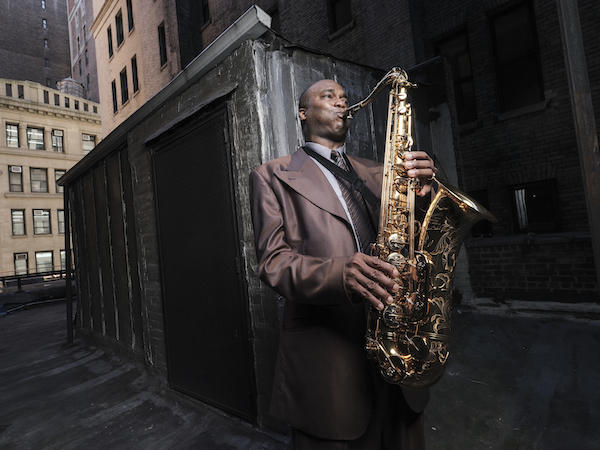Apr 2, 2024 12:59 PM
Saxophonist, Sonic Explorer Casey Benjamin Dies at 45
Casey Benjamin, the alto saxophonist, vocalist, keyboardist and producer who stamped his distinctive sounds on the…

Playing with European guitarists indebted to Django Reinhardt stuck with saxophonist James Carter.
(Photo: Jimmy & Dena Katz)On a temperate night in April 2017, James Carter was veering dangerously close to the intemperate. Jamming with other saxophone stars onstage at the State University of New York at Purchase, he seemed a man possessed—his tenor saxophone by turns wailing and whimpering, bleating and braying with a musicality so muscular it threatened to consume him.
It never did. Carter, a big man with a big heart, is by nature a maximalist. And the vehicle at hand—Sonny Rollins’ aptly titled “Tenor Madness”—seemed attuned to his more-is-more aesthetic. Among such distinguished players operating at full tilt—Jimmy Heath, Joe Lovano and Ravi Coltrane were part of the mix—Carter’s search for new sounds fit the moment, even as its urgency set him apart.
“I think it’s going to be a perpetual search,” he said between bites of quiche at a Manhattan pâtisserie this June.
At 50, Carter remains relentless. A child of Detroit and builder of the modern jazz scene in that city—where he still lives when not holed up in a pad on New York’s Upper West Side—he retains a reputation as an iconoclastic seeker of truth for whom each rush of air through his horn both aspires to rebellion and respects tradition.
“There are certain people God puts something extra in their pot; he’s one of them,” said violinist Regina Carter, his cousin and sometime collaborator. “But he definitely worked for it.”
In a career that’s encompassed symphonic collaborations, solo concerts and nearly everything in between, Carter’s expansive art has never quite settled into a comfort zone. Nor has the restless saxophonist sought one. But he has returned to a few subjects repeatedly—none, perhaps, more productively than Django Reinhardt (1910–’53).
First turned on to the iconic gypsy guitarist as a teenager by the programming of Detroit radio host Jim Gallert, Carter today is reimagining Reinhardt’s work for the second time. The project is one in which he and his bandmates—Gerard Gibbs on Hammond B-3 organ and Alex White on drums—incorporate rhythms and riffs from contemporary culture into songs associated with Reinhardt. The resulting sounds, in Carter’s words, give Reinhardt “a ’hood pass.” Fresh even by Carter’s high standards, those sounds hold the promise of wide appeal.
“This particular hybrid could be made available and relevant to new listeners,” he said.
The project has been gathering steam, generating excitement at both the 2017 Monterey Jazz Festival and last year’s Newport Jazz Festival. The upshot, Carter said, is that Blue Note Records, which had been weighing an in-studio Reinhardt album, decided instead to release James Carter Organ Trio: Live From Newport Jazz (produced by label head Don Was). The program includes five tunes by Reinhardt—including 11-minute renditions of both “Le Manoir De Mes Rêves” and “Mélodie Au Crépuscule”—and one by his contemporary Auguste “Gusti” Mahla, all recorded at the 2018 festival.
The new album, on which Carter plays soprano, alto and tenor saxophones, has its roots in an earlier encounter with Reinhardt, documented on Carter’s sixth album, 2000’s Chasin’ The Gypsy (Atlantic). For that project, he employed some of the more obscure horns in his considerable arsenal. Among them: the F-mezzo soprano saxophone and the bass saxophone, on which he rendered gems like “Nuages” and “I’ll Never Be The Same” with a lyricism that offers striking evidence of his ability to coax the most unlikely sounds out of the most unwieldy instruments.
That album’s debt to Reinhardt is clear in the way its two acoustic guitars, accordion and violin evoke the deep and sometimes dark colors of wartime Paris. Yet Carter’s imprint is unmistakable in the twists and turns the treatments take as he shapes his sonic world within Reinhardt’s universe. In a series of structured colloquies, for example, James and his cousin Regina recall the heat of Reinhardt’s interplay with violinist Stéphane Grappelli—while also molding the melodic contours in a manner that reflects a risk-it-all, Motor City sensibility.
“When you’re playing with James, you have to lose any preconceived expectations of what you think the music is and be willing to trust and hear James’ vision and put yourself out there,” Regina explained. “It can be uncomfortable because it’s so different.”

Benjamin possessed a fluid, round sound on the alto saxophone, and he was often most recognizable by the layers of electronic effects that he put onto the instrument.
Apr 2, 2024 12:59 PM
Casey Benjamin, the alto saxophonist, vocalist, keyboardist and producer who stamped his distinctive sounds on the…

“He’s constructing intelligent musical sentences that connect seamlessly, which is the most important part of linear playing,” Charles McPherson said of alto saxophonist Sonny Red.
Feb 27, 2024 1:40 PM
“I might not have felt this way 30 to 40 years ago, but I’ve reached a point where I can hear value in what people…

Albert “Tootie” Heath (1935–2024) followed in the tradition of drummer Kenny Clarke, his idol.
Apr 5, 2024 10:28 AM
Albert “Tootie” Heath, a drummer of impeccable taste and time who was the youngest of three jazz-legend brothers…

“Both of us are quite grounded in the craft, the tradition and the harmonic sense,” Rosenwinkel said of his experience playing with Allen. “Yet I felt we shared something mystical as well.”
Mar 12, 2024 11:42 AM
“There are a few musicians you hear where, as somebody once said, the molecules in the room change. Geri was one of…

Henry Threadgill performs with Zooid at Big Ears in Knoxville, Tennessee.
Apr 9, 2024 11:30 AM
Big Ears, the annual four-day music celebration that first took place in 2009 in Knoxville, Tennessee, could well be…